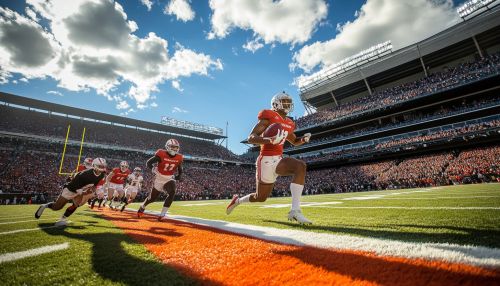College athletics in the United States
Overview
College athletics in the United States is a complex and multifaceted system that plays a significant role in the landscape of higher education. It encompasses a wide range of sports and activities, from football and basketball to less mainstream sports like lacrosse and rowing. College athletics is governed by various organizations, with the NCAA being the most prominent. This system not only provides opportunities for student-athletes to compete at a high level but also contributes significantly to the financial and cultural aspects of universities.
Historical Development
The history of college athletics in the United States dates back to the 19th century. The first intercollegiate competition was a rowing race between Harvard and Yale in 1852. This event marked the beginning of organized college sports, which quickly expanded to include other sports such as baseball and track and field.
The early 20th century saw the establishment of the NCAA in 1906, which was initially formed to address safety concerns in college football. Over the years, the NCAA evolved into a powerful governing body that oversees the rules and regulations of college sports. The organization has played a crucial role in shaping the modern landscape of college athletics, including the introduction of Title IX, which mandated gender equality in college sports.
Governance and Structure
College athletics in the United States is governed by several organizations, with the NCAA being the most influential. The NCAA is divided into three divisions (I, II, and III), each with its own set of rules and regulations. Division I schools are typically larger institutions with significant athletic budgets and offer athletic scholarships. Division II schools also offer scholarships but have smaller budgets, while Division III schools do not offer athletic scholarships and focus more on the student-athlete experience.
Other governing bodies include the NAIA and the NJCAA, which oversee smaller colleges and junior colleges, respectively. Each organization has its own governance structure, eligibility requirements, and championship events.
Financial Aspects
College athletics is a multi-billion dollar industry in the United States. Revenue is primarily generated through television contracts, ticket sales, sponsorships, and merchandise. The most lucrative sports are football and basketball, particularly at the Division I level. The College Football Playoff and March Madness are major revenue-generating events.
Despite the significant revenue, there is ongoing debate about the distribution of funds. Many argue that student-athletes should receive a share of the profits, leading to recent changes in NIL policies that allow athletes to earn money from endorsements. However, the financial landscape varies greatly between institutions, with some programs operating at a deficit.
Academic and Social Impact
College athletics has a profound impact on the academic and social environment of universities. Student-athletes often face the challenge of balancing rigorous training schedules with academic responsibilities. Many institutions provide support services such as tutoring and academic advising to help athletes succeed academically.
Socially, college sports foster a sense of community and school spirit. Events like homecoming games and rivalry matches are integral to campus life. However, there are concerns about the prioritization of athletics over academics and the potential exploitation of student-athletes.
Gender and Diversity Issues
Title IX, enacted in 1972, was a landmark legislation that transformed college athletics by requiring gender equality in sports programs. This led to a significant increase in opportunities for female athletes and the establishment of women's sports programs. Despite these advancements, gender disparities still exist, particularly in terms of funding and media coverage.
Diversity in college athletics is another critical issue. While there has been progress in increasing opportunities for minority athletes, challenges remain in areas such as coaching diversity and representation in leadership positions within athletic departments.
Challenges and Controversies
College athletics faces numerous challenges and controversies. The debate over amateurism and compensation for student-athletes is ongoing, with many advocating for a more equitable system. The commercialization of college sports has also raised ethical concerns about the exploitation of athletes.
Additionally, issues such as recruiting violations, academic scandals, and the health and safety of athletes are persistent challenges. The NCAA and other governing bodies continue to implement policies to address these issues, but the effectiveness of these measures is often debated.
Future of College Athletics
The future of college athletics is likely to be shaped by several key trends. The increasing influence of technology, such as data analytics and virtual training, is transforming how sports are played and managed. The ongoing evolution of NIL policies and potential reforms to the NCAA's governance structure will also impact the landscape of college sports.
Moreover, the focus on athlete well-being and mental health is expected to grow, with institutions investing more in support services. The push for greater diversity and inclusion will continue to be a priority, with efforts to ensure equitable opportunities for all student-athletes.


